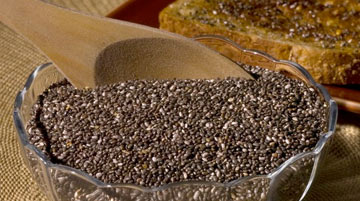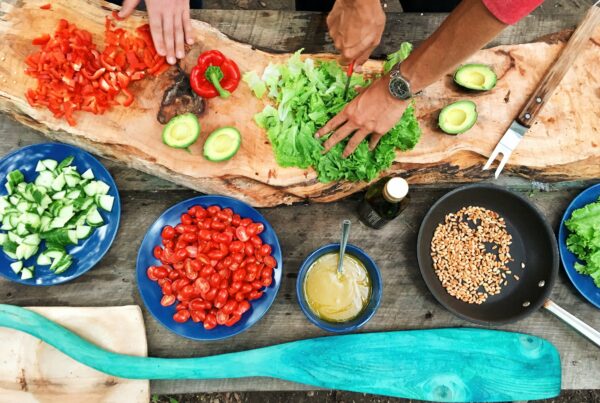 Although many of us will remember chia seeds from the 1970’s chia pets, chia seeds have been around since before Columbus discovered America. The Aztecs and Mayans used them as one of their our main crops along with corn, beans, and amaranth. They were used to pay tribute to conquering tribes, in religious ceremonies, and as payment to their priests and rulers. Chia seeds were the basic survival ration of Aztec warriors. I’ve read that one tablespoon was believed to sustain an individual for 24 hours. The Aztecs also used chia medicinally to stimulate saliva and to relieve joint pain. After the Spanish conquest, chia was banned becauseit was used as an offering during religious ceremonies and rituals. As a result it almost became extinct. Chia is actually the Mayan word for ‘strength.’
Although many of us will remember chia seeds from the 1970’s chia pets, chia seeds have been around since before Columbus discovered America. The Aztecs and Mayans used them as one of their our main crops along with corn, beans, and amaranth. They were used to pay tribute to conquering tribes, in religious ceremonies, and as payment to their priests and rulers. Chia seeds were the basic survival ration of Aztec warriors. I’ve read that one tablespoon was believed to sustain an individual for 24 hours. The Aztecs also used chia medicinally to stimulate saliva and to relieve joint pain. After the Spanish conquest, chia was banned becauseit was used as an offering during religious ceremonies and rituals. As a result it almost became extinct. Chia is actually the Mayan word for ‘strength.’
In the Southwest, Native American runners would carry a small pouch of seeds, and use them as nourishment to maintain strength and improve endurance. They were used by the Indians and missionaries as a poultice for gunshot wounds and other injuries.
Recently there’s been a lot of interest in chia seeds as scientists have discovered many nutritional benefits, including:
- 700% more Omega-3 than farmed or wild salmon
- 500% more calcium than milk
- 200% more iron than spinach
- 100% more potassium than bananas
- 1400% more magnesium than broccoli
- 100% more fiber than bran flakes
- 500% more protein than kidney beans
- 300% more selenium than flax seed
- 800% more phosphorus than whole milk
- More antioxidants than blueberries
- More folate than asparagus
- More lignans than flax
While chia has more omega-3 fatty acids than flax (it is also one of the highest known plant sources of omega-6), it is so rich in antioxidants that the seeds can be stored for long periods without becoming rancid. (Omega-3 fatty acids are a primary building block of every cell in your body. You need omega-3’s for proper cell membrane formation and function.) Unlike flax, chia can be digested by the body without needing to be ground into flour although the flour has been used for years to make pinole, a meal that can be used for porridge or baked goods.
Chia has a nut-like flavor, and you can sprinkle them ground or whole on cereal, in yogurt or salads, add them to your smoothies, mix them with flour when you’re making muffins or bread, or just eat them as a snack.
When mixed with water and allowed to sit for 30 minutes, chia forms a gel which can be used in puddings or salad dressings or eaten as is. In Mexico and Central America, chia seeds mixed with water, lime or lemon juice, and sugar is a drink known as “chia fresca.”
Chia seeds are also gluten free which is wonderful if you have gluten intolerance.
Chia Gel Recipe
Put nine parts of water into a seal-able container. Slowly pour one part seed into the water and whisk to avoid any clumping. Wait a few minutes and whisk again. Let chia seeds stand for about 10 more minutes, then stir again to break up any last clumps.
Store in your refrigerator for up to 2 weeks.
Add this gel to smoothies, mix it with salad dressings, puddings or granola, or simply eat it by the spoonful.
Chia Fresca
2 tsp chia seeds
10 oz water
juice of one lemon or lime
agave or raw honey to taste
Stir the ingredients together and enjoy.
Chia Seed Dressing
3/4 C raw honey
1/3 C raw apple cider vinegar
4 1/2 tsp grated onion
3 tsp ground mustard
1 tsp chia seeds
1/2 tsp Real Salt
1 C olive oil
In a small bowl, combine the first six ingredients. Slowly add the oil, while whisking briskly. Cover and refrigerate until serving. (If using olive oil, bring to room temperature before serving.)
Fruity Chia
3 small or 2 big apples
8 dates, pits removed
4-5 Tbsp chia seeds
1/4 C dried cranberries
Blend the apples and six of the dates together. Transfer that mixture into a bowl and stir in the chia seeds and cranberries. Chop the remaining 2 dates and stir those in too. Leave to soak for at least 10 minutes before eating.
Raw ‘Rice’ Pudding
4-5 Tbsp chia seed
2 C. milk (dairy or almond)
raw honey or agave to taste
Combine the ingredients to your taste. Leave the chia to soak for at least 10 minutes before eating. You can also add other flavors like vanilla or cinnamon.
This post was shared with The Healthy Home Economist and The Prairie Homestead.










Thank you for this post. I just ordered 6 lbs of Chai seeds. Have already made 3 different drinks with them. I plan to grind some and use them in baking…experiment, experiment!!!LOL!!!Polly